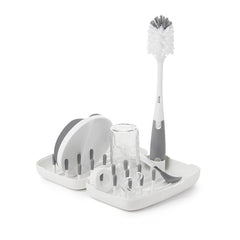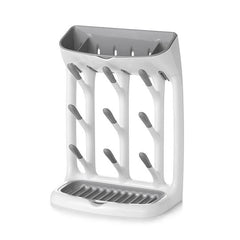
Keep your bottle feeding bub healthy and happy with our curated collection of baby bottle cleaners. From pacifiers and teats to breast pump machine parts and bottles, find the best brush, rack, steriliser or wash to keep everything sparkling clean.
Make cleaning baby bottles simple and stress-free
With how often parents use bottles, they need to make sure cleaning and caring for them is quick, easy and safe. Shop our collection of products formulated especially for cleaning baby bottles and other feeding items (even pacifiers and toys), to find the brushes, cleansers and drying racks designed to make your life easier.

Best cleaning and sterilising equipment
When you bottle feed, you need to make sure to carefully clean and sterilise all equipment routinely. Babies’ still-developing immune systems are weaker than adults, making them susceptible to infections from germs and bacteria. Purchasing the best equipment for your needs and budget ensures your baby is kept happy and healthy.
Range of different equipment
Luckily there are a variety of cleaning and sterilising products available to make this chore faster and easier. From drying racks to bottle cleaning brushes and liquid cleanser to antibacterial tablets, there's enough equipment for every cleaning need.

Bottle feeding - A list of equipment you may need
● Feeding bottles, including caps and collars
● Teats/bottle nipples
● Formula or breast milk
● Breast pump (if you are breastfeeding as well)
● Brushes: Bristle bottle brushes, silicone bottle brushes and straw brushes
● Sterilising equipment
Most effective way to clean bottle-feeding equipment
Follow these steps for the most effective way to clean all your bottle feeding products:
1. Wash hands thoroughly with warm soapy water, and dry.
2. Take apart, rinse and then wash all bottle feeding equipment in hot, soapy water. Throw out any cracked or damaged items like teats.
3. Use a bottle brush to thoroughly clean bottles and nipples, making sure the brush head reaches all hard-to-reach areas. Concentrate on screw tops, lids and teats (and any other area bacteria can easily grow).
4. Rinse everything well, ensuring you squirt water through teats (to remove any plugs of milk).
5. Allow to air dry.

Sterilising bottle feeding equipment
Sterilising bottle feeding equipment is an essential part of bottle feeding to keep viruses, bacteria and parasites away from your precious one. Whatever method you choose, you need to make sure you follow a thorough process from beginning to end, starting with washing your hands well.
● The boiling water method is a simple process of placing bottles, teats, caps, breast pump parts, etc, in a large saucepan of boiling water for 5 minutes, and then air drying.
● For steam sterilisation you need to purchase a steam steriliser (either electric or for use in a microwave), which you place items into for a sterilisation cycle.
● There is also a cold water sterilisation method, which uses chemicals to clean. This method requires rigorous attention to detail to guarantee safety both for you and baby.
Sterilising equipment available
If you want a choice other than the boiling water or chemical sterilising methods, there is a plethora of sterilising equipment to choose from like sterilising wands, UV sterilisers, microwave steam sterilisers and electric steam sterilisers.

Best baby bottle brushes
Not only do normal dish brushes, sponges or cloths not cut it when cleaning baby bottles, they also harbour germs and bacteria and allow for cross-contamination. Using a brush specifically designed for baby bottle cleaning, is a time-saving, safe and easier way to clean baby bottles and other baby feeding equipment.
How to choose a bottle brush
● Length: Make sure it's long enough to reach the bottom of your bottles with enough handle space to be comfortable.
● Types of bristles: Mostly nylon, bristles come in angled and mixed textures for gentle and tough cleaning.
● Non-slip handle: Helps grip when cleaning with soapy water.
● Sponge tip: Cleans hard to reach places.
● Flexible neck: To reach every nook and cranny.
Cleaning your baby’s bottle effectively
Proper cleaning of a baby bottle, with hot water and soap, is incredibly important to help bub stave off germs. Neither breast milk or formula are sterile products, which means germs can rapidly grow in bottles that are not effectively cleaned and dried after use.

Can you put a bottle brush in the dishwasher
Some bottle brushes are dishwasher safe, while others are best hand washed. Check with the bottle’s manufacturer for specific cleaning instructions.
What dish soap is best for baby bottles
When washing baby bottles, it’s best to use a fragrance-free cleanser specially formulated for them, as they are effective at removing tough milk stains, while being safe for bottles and bub!
Brands we recommend
Metro Baby stocks a selection of best sellers from brands such as Medela, Avent, Oxo Tot, Pigeon, Milton and B. Box.
Buying online with Metro Baby!
From BPA-free bottle and nipple brushes to brush cleaning sets and drying racks, Metro Baby makes buying any baby product an easy and fun experience.
Frequently Asked Questions About Baby Bottle Cleaners:
How do you clean baby bottles?
Baby bottles need to be properly washed with warm, soapy water and a bottle brush specifically designed and reserved for cleaning baby feeding equipment. Metro Baby’s items have been selected specifically for their ability to make cleaning baby bottles simple and easy. For example, a brush set like Oxo Tot's Water Bottle and Straw Cup Cleaning Set helps clean narrow necked bottles, straws and all the tiny crevices found in bottle tops and lids. If you have any more questions about our baby bottles or need advice on cleaning them, please contact us to speak with one of our helpful customer service team members.
Do you really need to sterilise baby bottles?
Yes, you do need to sterilise baby bottles as a baby is still developing and strengthening their immune system for the first few months of life. To help make sterilising easier, have a look at our sterilisers to find a machine to do the job for you.
What is a safe way to clean baby bottles?
The safest way to clean baby bottles is to do so with hot, soapy water and a baby bottle brush (only used for cleaning bottles and other baby feeding items). Make sure to thoroughly clean all cracks and crevices (including bottle and lid screw tops and holes in teats), rinse and air dry. Sterilisers are also a safe way to clean baby bottles, and a smart item to add to your gift registry.
What age do you stop sterilising baby bottles?
It's recommended that you sterilise baby bottles and other baby feeding equipment until your baby is at least 12 months old. Hopefully by 6-9 months, your child will be able to use a sippy cup, reducing the amount of bottles you need to clean. Until then, utilise our quick and free shipping (for orders over $99 AUD) to order more bottles as you need them.











































